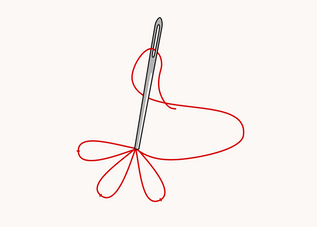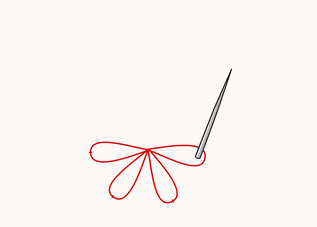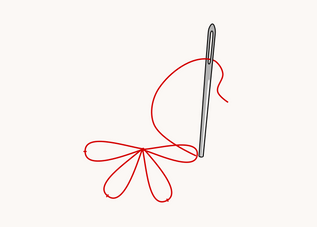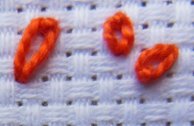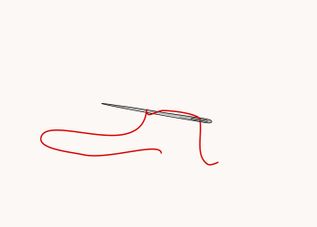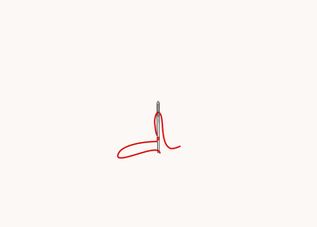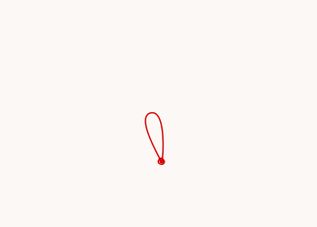Click on the images to enlarge them!
Isolated Stitches
Detached Chain Stitch
<<< mobile phones: drag the table to the left to see the whole entry <<<
Deutsch | Margeritenstich |
English | detached chain stitch, tail chain stitch, (tied) loop stitch, knotted knot stitch, picot stitch, lazy daisy |
Español | punto de margarita |
Français | point de chaînette isolé, point de bouclette, point de vierge, point marguerite |
Italiano | punto margherita |
Nederlands | losse kettingsteek |
Polski | ścieg stokrotkowy |
Português | ponto margarida, ponto malmequer |
Pусский | цепочка в прикреп |
Svenska | öglestygn, mille fleurs |
The detached chain stitch, also answering to the pretty name "laizy daisy", works exactly the same way as the chain stitch itself, save that the beginning and the end of the line coincide in one single stitch, that is the first (stitch) shall be (the) last (stitch).
As the name of this stitch implies in almost all languages - and as you can see at first glance - this stitch is perfect for working all kinds of flowers, leaves and floral motifs. And it is easy to modify: if you wish to change its shape a bit (say, to widen it), just work a couple of anchoring stitches more around the loop. I did this in my very first sampler, where I dubbed it the "Not So Lazy Daisy Stitch".
Detached Chain Stitch
French Knot
<<< mobile phones: drag the table to the left to see the whole entry <<<
Čeština | francouzský steh |
Deutsch | Knötchenstich |
English | French knot, twisted knot stitch, wound stitch, French dot, knotted stitch |
Español | nudo francés |
Français | point de noeud |
Italiano | punto nodini, nodo francese |
Kaszëbsczi | wãzełk |
Nederlands | Frans knoopje |
Polski | haft supełkowy, haft węzełkowy, haft perełkowy |
Português | ponto de nó, nozinho, (ponto) nó francês |
Svenska | franks knut |
Some love it, others hate it. I belong to the former. Some people stitch whole pictures with it. Okay, I don't love it that much. But the French knot can also become your friend if you follow a few simple rules.
Working the French knot, it's best to have both hands free, but with a little dexterity you can manage with hoop held in your hand as well.
First come up with your needle where you want the knot to be. Then wrap the thread around the needle. Purists insist on wrapping it only once. I say: suck it and see. I've already wrapped it around five times and I liked what I saw.
But now comes an important rule: put the needle in the fabric again, yet not through, but attention! Do NOT stick it in the exact same hole you came out of! In most cases, this is the cause of a lot of tangle and frustration. Instead, go down just a little bit next to it. Hold the needle with one hand and the thread with the other (this is why it is really comfortable to have both hands free) and pull gently but firmly on the thread so that it tightens around the needle. In this position you can move the needle up and down a little to see if it slides through easily, and you can also see if the knot sits well and looks good.
When everything fits, pull the needle gently through the knot from below – et voilà! Un nœud français.
French Knot
Credits for the multi-language stitch names:
agulhas da méri, Illustrated Glossary of Embroidery Stitches - 1
Dictionary of Stitches.docx - source unknown, please give me a hint, if you know something about the authorship (maybe an Italian blog?)
Mary Thomas's Dictionary of Embroidery Stitches
Pumora Embroidery, Lexikon der Stickstiche
KUFER z artystycznym rękodziełem
Ateljé Margaretha, Sömsätt
Marina Pastushenko
Mary Corbet, Needle'n Thread
Wikipedia


